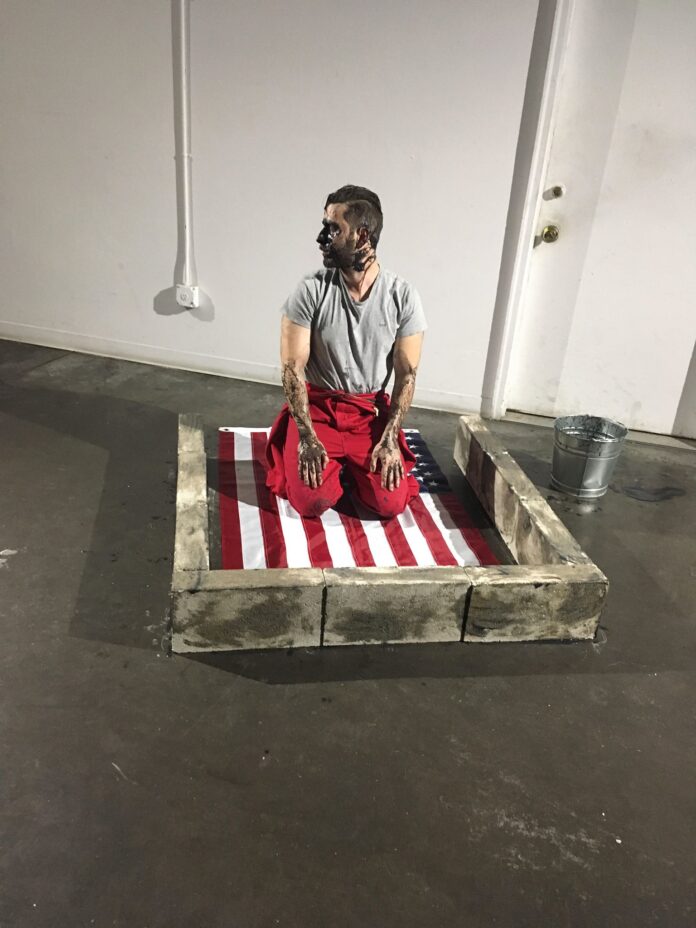The author of this blog post requested to remain anonymous.
Do you consider yourself an ally to immigrants and artists of color? White viewership’s failure to utilize an intersectional lens when analyzing works of art results in biased interpretations, partial or thwarted exhibition opportunities and hindered diversity in available academic scholarship, which in turn further perpetuates the problem. It is only through a conscious effort that this cycle can come to an end. Performance art in particular, when presented in an exhibition setting, uniquely challenges the viewer to engage and participate in the work’s meaning and places viewers in a position of discomfort and choice making. It is in these complex and uncomfortable moments that one is challenged to think critically and discover an empathy for the lived experiences of others.
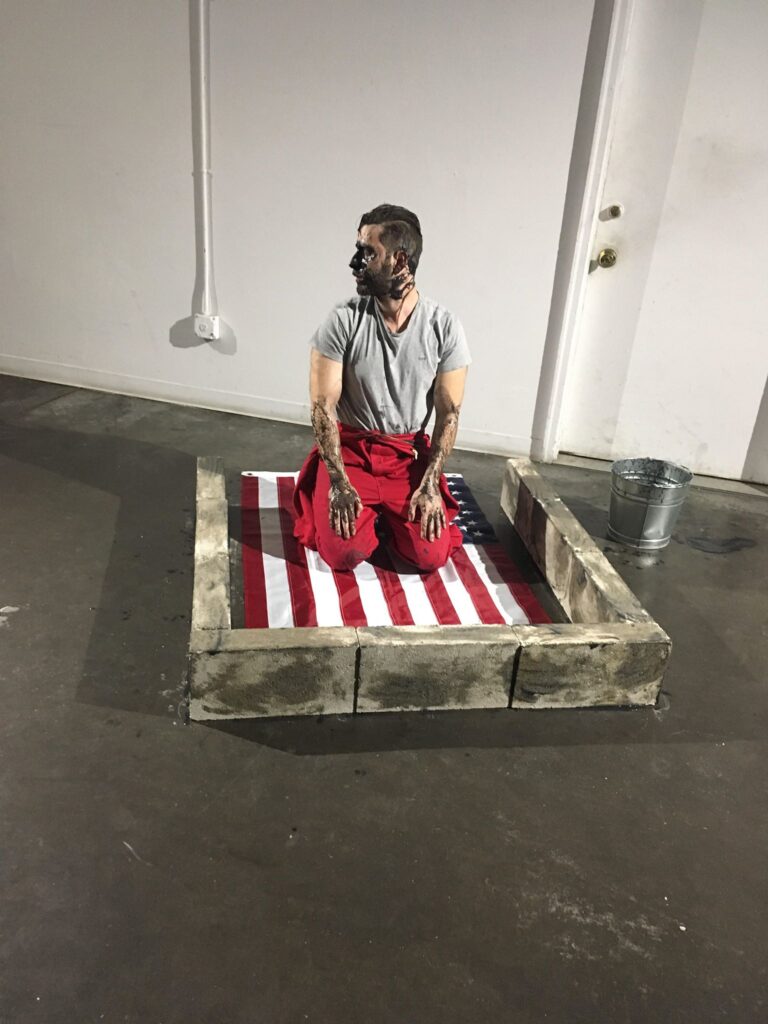
The current exhibition at the UW-Milwaukee Union Art Gallery (UAG) titled Here to Stay: Braving Barriers Through Performance set out to do just these things. Surprisingly, UWM—the same institution that touts “radical inclusivity” and claims to support Black Lives Matter—censored this exhibition out of fear of a potential misinterpretation of one Syrian American artist’s performance which involved the American flag. Through persistence, the UAG’s staff and UWM academic faculty were able to reinstate the online version of the show, however the gallery’s physical doors still remain closed to the public almost 5 weeks later.
In September of 2019 the UAG contacted faculty at the School of the Art Institute of Chicago (SAIC) in search of a performance artist whose work could sustain an exhibition space for an extended period of time. They highly recommended Syrian-born performance artist Sami Ismat, who at the time was a current SAIC graduate student and TA. Shortly thereafter, the curator travelled to Chicago to experience the performance of his piece Every Time I Step Toward Freedom. It brought her to tears and while potentially controversial, she felt his piece would be well-received by the UAG’s academic audience. After all, the upside to academic galleries is a greater freedom to explore complex ideas and challenging topics. Sami’s work was personal, impactful and socially relevant, calling upon acceptance, democracy and humanity in this time of political unrest and division. The next month Sami drove to Milwaukee and met with the curator and the Gallery Director where he detailed how his work aimed to redefine “Americanness” and challenge the traditional acceptance of who an American is. As an asylum-seeker, Sami is now an American citizen, but has found that, when challenged or uncomfortable, those who claim to be his ally are often nowhere to be seen. He explained that this performance aims to open up a discussion on the boundaries of allyship. Can you be an ally to him when he is kneeling on an American flag covered in mud and praying in a foreign language? After discussing this piece as a group, the UAG agreed that the work aligned with its mission as an educational space, dedicated to diversity and inclusion.
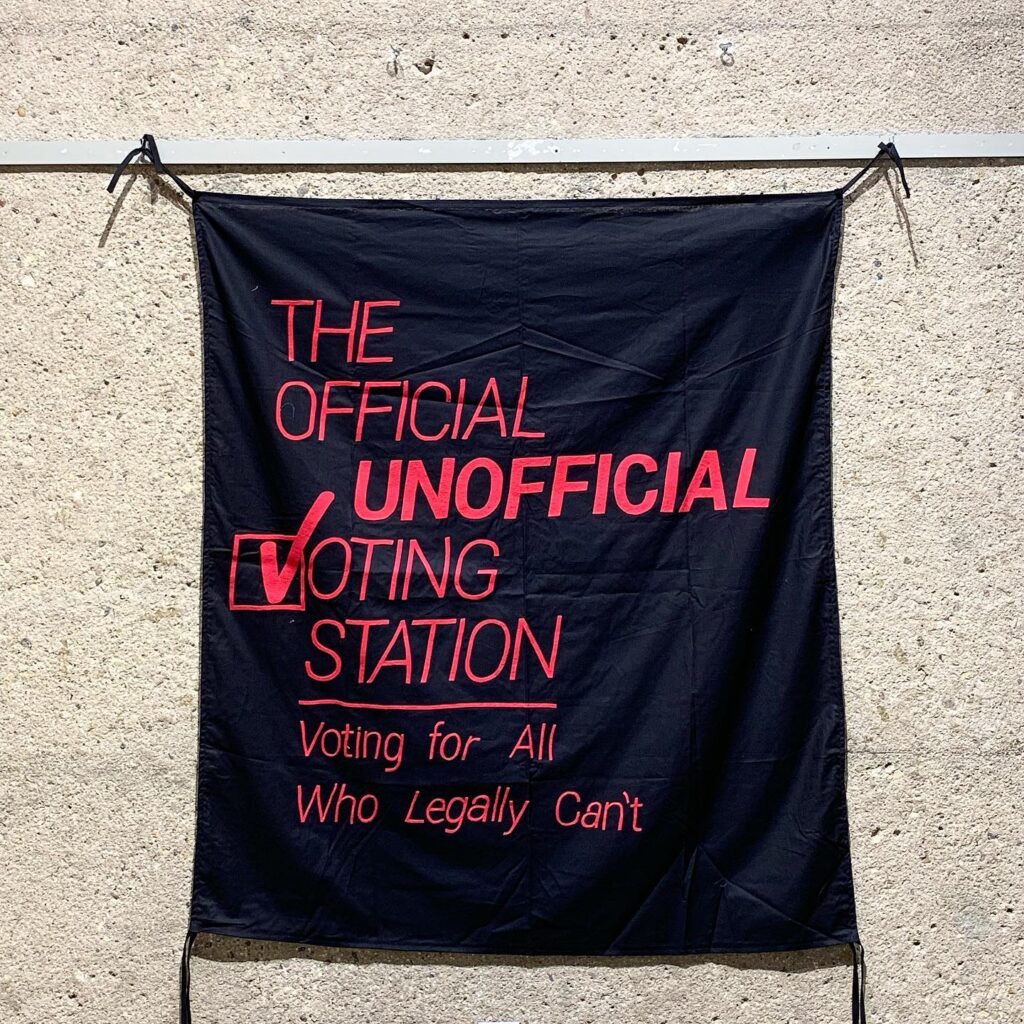
In conversation with Sami, another Chicago-based installation and performance artist Aram Han Sifuente’s work was chosen for the gallery space. Aram’s installation of Voting Kits for the Disenfranchised (as part of the Official Unofficial Voting Station: Voting for All Who Legally Can’t) presents voting stations that symbolically provide a voice to those who otherwise may not have one in the upcoming presidential election. As a Korean-American, Aram’s work offers a platform for the inclusion of the lived experiences of similarly underrepresented communities. Four of her word-based curtains were also chosen, portraying bold statements surrounding themes of immigrant rights and systemic oppression presented in a variety of languages. And finally, Aram’s A Mend series was chosen, highlighting the politics of immigrant sweat labor in the United States through the use of hand-stitched denim scraps.
Tapping into the broader Milwaukee art community to round out this exhibition, the curator noticed that UWM alumni Jeanette Arellano’s name kept coming up. Jeanette is an interdisciplinary Latinx activist, artist and bilingual youth educator known for her monumental protest banners, social activism and community work within Milwaukee’s south side in connection with Voces de los Artistas, Artbuild Workers and Raices Revolucionarias. Her first submission for Here to Stay, a hand-painted 5’ X 7’ protest banner titled Cuando Votamos Luchamos, is a collaboration piece created with her students at Walker’s Point Youth Emerging Art Leader Fellows in Art and Activism. Incorporating images of Milwaukee immigrants and workers who participated in the Strausse worker’s strike for PPE and the Justice March for Joel Acevedo, the banner was installed at South Division High School, Milwaukee’s largest Latinx voting site, during the recent August election. Additionally, forty face masks titled Voto Por were installed touting hand-painted reasons to vote in the Spanish language. Jeanette states, “While masks are meant to protect people’s mouths, they are also meant to protect their beliefs. These masks are a physical representation of strength, power and unity within immigrants, dreamers, separated families, first generation voters and naturalized citizens.” Suspended in front of the gallery’s brut concrete walls, this haunting installation speaks for the mask’s missing occupants.
The final two components of the show attempt to give a voice to the UWM student body and the exhibition visitors. With the help of Josie Osborne, Director of the First Year Program for UWM’s Peck School of the Arts and UWM student organizer Austin Piszczek, the UAG held an online submission and selection process for related artworks. They decided on the inclusion of works by Nadia Abdel-Karim Ahmad Al-Khun, Laura Lena Bogyay, Isabel Castro, Jovanny Hernandez Caballero, Austin Piszczek, and Bella Nkaujzong Vang. Additionally, a comment wall was implemented to extend an opportunity for inclusion and dialogue to the public.
A story about an exhibition in 2020, however, wouldn’t be complete without mention of COVID-19. In March 2020 the gallery was shut down. Despite this, the exhibition, called “Performing Americanness” among staff, maintained a planned opening of August 31 to coincide with the Milwaukee Democratic National Convention and was to remain open in the months prior to the presidential election. Coincidentally, the Union Ballroom across the hall from the gallery was scheduled to be a polling place. Additionally, the UAG had been collaborating on marketing and programming with the Emile H. Mathis Gallery in the Art History Department as they too were preparing their exhibition Hostile Terrain 94 (HT94), which explored parallel themes in immigration and belonging.
In light of COVID-19, the curator immediately began researching how to present exhibitions in a virtual format and worked with UWM’s IT department to build a new virtual exhibition website to house future shows. Additionally, they teamed up with UWM’s Student Involvement communications department to host all programming live on their Instagram account. Whether the exhibitions and programming were in person, or not, the UAG had it covered. Over the summer the curator met directly with UWM Union administration once a week to create a gallery reopening plan and an exhibition safety proposal to lay out every detail of this performative and interactive exhibition. Images of Sami’s performance were submitted to them for review as well as to UWM’s Union marketing department to choose from and design the marketing materials. In addition, the proposed title and show description were discussed with the artists; through a transparent and inclusive conversation the final title Here to Stay: Braving Barriers Through Performance was chosen. By mid-July the Union Director (not to be confused with the Gallery Director) approved the gallery’s safety and opening proposals and the UAG was given approval to begin installing the exhibition come August 17. Shortly thereafter, the gallery reached out to the Military & Veterans Resource Center (MAVRC) and the Muslim Student Association (MSA) on campus to offer an opportunity to engage in programming focused on constructive dialogue of these sensitive issues. While the organizations declined, they gave the gallery their best wishes and expressed an appreciation for the opportunity.
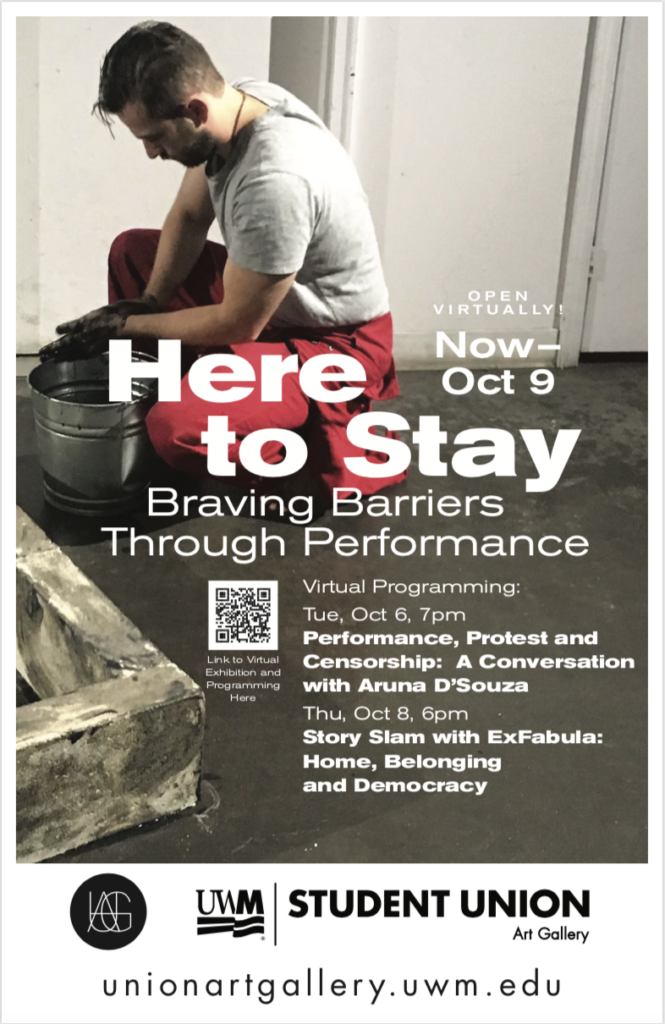
On August 18, thirteen days before Sami’s scheduled performances for the opening of Here To Stay, someone in Union Administration saw the proposed marketing materials and had a sudden concern about Sami’s performance and its use of the American flag. The gallery was asked to reconsider the marketing materials and remove any images of the flag. They were warned that the show may need to go on without Sami’s performance, or at least without it being streamed live on Student Involvement’s IG account. The gallery staff was told that while the Union Director took time to present these concerns to the Chancellor and the Provost, staff were not to speak to anyone about this situation. Seven days before the show opening, the curator took it upon herself to make the first online marketing post to promote the show on the UAG’s Facebook account. This post made no mention of Sami or his work and simply presented a piece by one of the UWM student artists. This act was met with immediate upset and resulted in a “middle-of-the night” erasure of any online mention of the exhibition including Facebook, Instagram, the UWM website and all calendars. The UAG staff was again advised by Union Administration to sit patiently and to avoid any conversation with the artists until word was received back. In the meantime, Sami’s performance times were deleted from the UAG’s SignUpGenius and it was made known to the gallery staff that the Union Administration would hand-select any attendees for his show, if the exhibition moved forward with the performance at all.
Finally, four days before the scheduled opening, the curator was advised that the gallery was to be shut down for the fall semester. The Union Administration stated that they received word the day before that the Union Ballroom across from the gallery was now going to be turned into a COVID-19 testing unit and that the voting, which had originally been scheduled there, would be moved elsewhere. Because of the gallery’s proximity to the ballroom it was explained that the gallery would need to close immediately for the safety of the gallery staff. Although the show was already fully installed and the virtual platform ready to move forward as planned, the Union Administration consistently said that they were no longer willing to move forward with the online version of the show either and that “things were too complicated and there was no further room for discussion.” The curator was told that as a UWM employee she had a responsibility to prioritize the needs of the institution above all else in these difficult times. But when we value the needs of an institutional image above the voices of individuals, particularly marginalized individuals, we send a clear message that their perspectives don’t matter. This is the definition of systemic racism. To quote one of Aram’s pieces that currently hangs on the dark gallery walls, “A System Cannot Protect Those Which It Was Never Designed to Protect.”
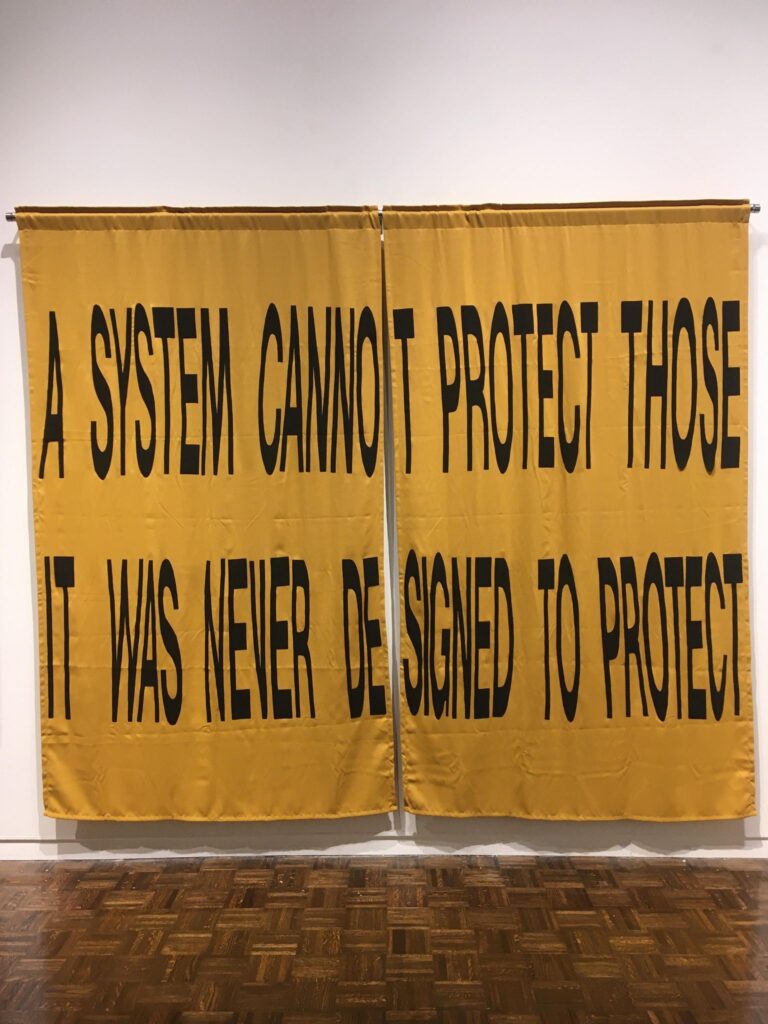
After advising the curator of her responsibility to the institution, Union administration took it upon themselves to inform the artists of the cancellation of the show, providing the COVID-19 testing center as reasoning. That evening the curator spoke honestly with all of the artists regarding her concerns. Similarly, Peck School faculty emailed the Chancellor and the Provost and the decision to shut down the online version of the show was overturned the next day. While the UAG won this small battle, it was not without heavy losses. Sami’s performances, including Every Time I Step Toward Freedom-the work that the show was built around, will never take place on UWM soil. As a result of all this, Sami has stated that he does not feel safe on our campus and will not come here. The artists and faculty at SAIC will forever have this negative memory of UWM and the curator, a graduate student in Art History, will forever be haunted by these experiences.
In an attempt to give Sami’s work some sort of platform throughout all of this, a video link has been embedded in the virtual exhibition presenting the images that the curator took during the 2019 performance with a voiceover. To date (October 1, 2020), the artwork in the gallery remains installed on the gallery walls, yet the doors remain closed and the lights off. For the first two weeks of classes, the COVID-19 unit was not open, yet the gallery was still forced to remain closed. Since then, the COVID-19 unit has had a minor trickling in of students—nowhere near the 500-1,000 students Union administration claimed would be in line every day. The doors of the gallery’s neighboring offices, which are closer to the ballroom than the gallery itself and include the Panther Card Office and the Inclusive Excellence Center, remain open while the gallery sits dark. When pressured to explain this, the Union Administration would not reply for over a week. They finally replied that the Union building had a power outage on September 8, which caused an air unit system to malfunction and explained that it only affects the gallery’s air circulation. They further explained that they have no idea how long it will take to fix it. In the meantime, the echoes of student protesters and chants of “Black Lives Matter” and “No Justice, No Peace” can be heard from inside the gallery walls, yet the gallery itself sits dark, filled with unseen messages by recent immigrants and artists of color, addressing immigration, inclusivity and democracy.
In an effort to help atone for the events surrounding this exhibition, the UWM Union has agreed to allow the gallery to bring in scholar and author of Whitewalling: Art, Race and Protest in 3 Acts Aruna D’Souza to present her research and lead a transparent conversation with the artists and curator of Here to Stay on October 6. I ask that you please join the UAG for this virtual programming event, which is sure to be powerful and eye opening. The event has limited attendance and preregistration is required. The SignUpGenius for this event can be found here.

